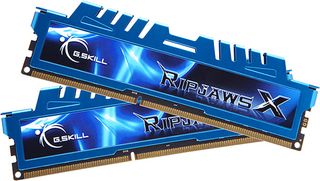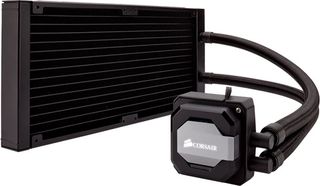CPU Performance In VR: 11 Games Benchmarked
Introduction
When HTC’s Vive launched at $800 and Oculus’ original incarnation of the Rift surfaced for $600, friends and family made it a point to stop by my place for their first tastes of VR. Most of them loved the experience, but nobody ran out and bought an HMD of their own.
More recently, the Rift + Touch kit went on sale for $400, while HTC permanently dropped the Vive’s price to $600. Suddenly, people I know were taking the leap and asking for help building fast-enough PCs. Most of all, I encouraged, buy as much graphics horsepower as possible.
But what about the platform that beefy GPU lives on? How much muscle do you need backing up your favorite GeForce or Radeon card? Oculus sets the bar low, specifying a Core i3-6100, Ryzen 3 1200, or FX-4350 at minimum. However, the company recommends a Core i5-4590, Ryzen 5 1500X or more. HTC suggests a Core i5-4590 or FX-8350 at least. If only there was a way to quantify the benefit of stepping up from entry-level to a more potent host processor...
As it turns out, we’ve already done a fair bit of work to establish a toolset and methodology for benchmarking PC hardware in virtual reality. If you haven’t already read our primer, check out FCAT VR: GPU And CPU Performance in Virtual Reality. That piece introduces the VR rendering pipeline, two approaches to collecting performance data, the ways we can present it, and it introduces our first batch of results. We showed how Oculus’ asynchronous spacewarp technology works, how quality settings affect a game like Chronos, how Nvidia’s Pascal and Maxwell architectures stack up to each other, and how AMD’s Graphics Core Next architecture compared earlier in 2017.
On one page at the very back of our story, we took a peek at host processor performance in Arizona Sunshine, a game purportedly imbued with special CPU extras for owners of Core i7 CPUs (which of course made it controversial). It turned out that a Core i7-6950X and Core i7-6700K did, in fact, enjoy a performance advantage over Core i5-6600K. And all three Intel chips decimated AMD’s FX-8320.
Eager to expand on those initial findings, we put together five distinct platforms, came up with ways to test 11 different Oculus Rift titles, and talked to some of the developers about the ways they utilized host processing resources in their VR games.
What (And How) We Tested 11 Different Games in VR
Compiling all of the necessary hardware was our first challenge to overcome. Again, we’re an international team, and launch-day hardware gets spread all over the world. A few companies stepped in to help fill in the holes, expressing interest in answering the same questions we were asking.
Stay on the Cutting Edge
Join the experts who read Tom's Hardware for the inside track on enthusiast PC tech news — and have for over 25 years. We'll send breaking news and in-depth reviews of CPUs, GPUs, AI, maker hardware and more straight to your inbox.


MSI set up all of our host platforms, providing its X299 Gaming Pro Carbon AC (for Skylake-X), Z270 Gaming Pro Carbon (for Kaby Lake and Skylake), X370 Xpower Gaming Titanium (for Summit Ridge), and 990FXA-GD80 (for Vishera).


The company also sent over a Core i9-7900X for us to use as an ultra-high-end contender. We added our own Core i7-7700K to represent the top of Intel’s mainstream Kaby Lake family, and we purchased a Ryzen 7 1800X to compare the performance of AMD’s Zen architecture. Core i3-6320 and FX-8350 serve as floors, upon which the faster CPUs build.


Given Ryzen’s sensitivity to memory performance, we knew our choice in DDR4 would be scrutinized. G.Skill sent its F4-3200C14D-16GFX FlareX kit to complement the Ryzen 7 1800X and its F4-3200C14Q-32GTZ kit for our other DDR4-based configurations. Both were set to 3200 MT/s for testing.

We used a F3-2133C10Q-16GXM Ripjaws X kit at 2133 MT/s to go with AMD’s FX-8350. In this way, we were able to maximize throughput on every platform. The CPUs with dual-channel memory controllers were limited to 16GB (from one DIMM per channel), while the X299 setup featured 32GB (allowing the same one DIMM per channel).
In an effort to give each platform comparable thermal performance, we approached Corsair about a high-end closed-loop solution that we could use on Skylake-X, Socket AM4, LGA 1151, and Socket AM3+. The company sent over its Hydro-series H110i, which not only fit all of our test platforms, but also facilitates the cooling needed to keep our Core i9 from throttling.

Everything else was held constant. We used a GeForce GTX 1080 Ti to alleviate graphics bottlenecks as much as possible, a 500GB Crucial MX200 SSD, and the familiar be quiet! Dark Power Pro 10 850W PSU. Windows 10 was installed fresh and completely updated before we started downloading games from Oculus’ store.
| Test Equipment | |
|---|---|
| Cooling | Corsair H110i |
| CPU | Core i9-7900XCore i7-7700KCore i3 6320Ryzen 7 1800XFX-8350 |
| Graphics | EVGA GTX 1080 Ti |
| Memory | Flare X 16GB DDR4-3200Trident Z (32GB) |
| Motherboard | MSI X299 Gaming Pro Carbon ACZ270 Gaming Pro CarbonX370 XPower Gaming TitaniumMSI 990FXA-GD80 |
| PSU | be quiet! Dark Power Pro 10 850W |
| Storage | MX500 SSD |
We still have two PCs sitting side-by-side able to collect data using the hardware- or software-based approaches to FCAT VR. Our primer established the software version’s efficacy, though, so we’re using that utility exclusively to save time and provide insight not otherwise available from video-based analysis (such as unconstrained frame rate, calculated from real frame time measurements).
Again, if you’re interested in learning more about hardware performance in VR and want to get the most out of today’s deep-dive, FCAT VR: GPU And CPU Performance in Virtual Reality is the best place to start.
MORE: Best CPUs
MORE: Intel & AMD Processor Hierarchy
MORE: All CPUs Content
-
lightofhonor At the end you recommend the Ryzen 5/i5 but don't actually test it. Also, a 1700 or 1700X would be a better apples-to-apples 7700K price comparison.Reply -
zippyzion Great article and lots of good testing. Now, since we've determined the best CPU for VR, do you think, perhaps, that you could take different GPUs and slot them into a 7700K system to give us relative GPU performance? Say from the RX 480/580, 1060, 1070, 1080, and 1080Ti? Or possibly throw a Vega into the mix?Reply
You might also consider doing a VR at budget review pairing components that make sense in different budget segments. Like an i3 or i5/RX 480 or 1600, i5/1060 or 1070, i7/1070 or 1080, or something like that.
If the goal is to help speed up VR adoption we need ideas of how VR would work on a variety of system configurations. If people don't know if their borderline system can handle VR without an upgrade, they aren't going to even try it. -
Sakkura I don't know why you disregard the minimum requirements specified by Oculus, when your tests confirm that a Core i3 and FX CPU both run well with ASW. That was the whole point of Oculus lowering system requirements - the ASW feature means the system can be basically half as powerful and still deliver a playable experience.Reply
Of course you wouldn't want to combine a GTX 1080 Ti with a low-end CPU like that, but a Core i3 or FX CPU with a GTX 1050 Ti will get you going in VR.
I'm also disappointed that you didn't include Lone Echo in the test. A lot more relevant than a mobile port like Gunjack, and it seems to be one of the most CPU-intensive VR games so far.
But at the end of the day it's still great to get some data on general VR performance.
Next up, maybe a Core i5-7600K and some older-gen chips from Intel? People don't all have the newest hardware, and might want to see if they can get a VR headset without a PC platform upgrade. -
cangelini The Core i3 had dropped-frame issues in CryEngine-based games that ASW didn't fix--for that reason, I'd try to free up budget for a quad-core if possible. The FX, of course, simply isn't balanced with a 1080 Ti (a point I tried to make in the conclusion after looking at the experiment's data). In the ends, as with regular PC gaming, it's a question of whether you want to "get going in VR" or have some room to turn up details and render 90 real frames per second. Leaning on ASW exclusively does introduce artifacts of its own--maybe we can illustrate that with slowed-down video in an upcoming piece (screenshots from the primer story may not be enough?). Thank you for the feedback!Reply
Chris -
kokolordas15 Please retest Pcars with a proper framerate.If you could also specify how many cars you have enabled in the run that would be nice.Reply
The CPU gets hit extremely hard the more cars you add. -
artk2219 These results are great data points but as other have pointed out, it seems you opened up a can of worms :-/. What about different configurations, different settings, older hardware, R9 290's instead of RX 480's / 580's etc etc. I love what you've given us so far, and i know you are definitely under time and budget constraints, but this begs a follow up article with more data points. Thanks for all you guys do though, i know you work hard and put out the best that you can, its just never enough for some of us :).Reply -
pdlevers I would be curious to see how a 2600k/2700k overclocked stacks up. A lot of people are stilling running those workhorses, and in many games they perform quite well despite being 5-6 years old.Reply -
sucker25 Well I have a 3770k running at 4.6 ghz with a 1080 ti ...............with the htc vive all my vr games run flawlessly.Reply
neither my video card nor cpu hit the 100% utilization mark.
if I had to I could still get a little more out of my cpu as I'm only hitting 40 degrees c.
was thinking of upgrading to 7700k but imo the difference in performance would be marginal.......so I will wait a little longer. -
chalabam I watched all those games on youtube, and not a single one made me want to play the game.Reply
Sorry, but 3D by itself is not a good reason to buy VR. All 3D games suck. -
Scarystuff1970 I wonder why every test have dropped frames? Have you done any investigation into what causes them? Even Gunjack with more than 400 fps have dropped frames? There must be a problem with a Windows process halting everything else? Maybe the same problem that have plaqued Win10 since the Creators Update with lag spikes in all games?Reply
Also I think it would maybe have been more appropiate if you had disabled ASW in these tests?
Most Popular







